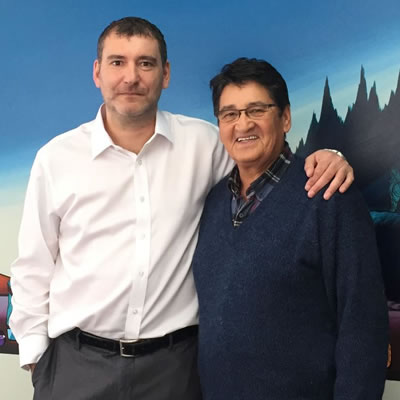Connecting communities at Rainy River and beyond

Jamie Saulnier (L) is the founder of Running Deer Resources and former National Chief Ovide Mercredi is an advisory board member. — Photo courtesy Run
Jamie Saulnier (L) is the founder of Running Deer Resources and former National Chief Ovide Mercredi is an advisory board member. — Photo courtesy Running Deer Resources
Jamie Saulnier first founded Running Deer Resources in 2001. His background in mining construction launched the company into success within the resource sector with a focus on mining. However, as the company grew, Saulnier noticed a major challenge the resource sector faces: building lasting relationships between companies and the Aboriginal communities surrounding projects.
“I realized that operating in the resource sector also involved working with Indigenous people and communities,” Saulnier said. At the time, relationships between companies and Aboriginal communities were either non-existent or primarily negative. “I set out to try to understand the challenges that communities and employers in Canada face with regards to employment and training,” he said.
Inspired to connect these communities with employment opportunities and focusing on building lasting relationships between employers and workers, Saulnier brought his business partner Kliff Lengwenus on in 2007 to take over the construction business. The company split to become RDR Industrial and Running Deer Resources so Saulier could pursue engagement strategies.
Understanding the challenge of connecting mining companies and Aboriginal communities
The biggest challenge when it comes to connecting Aboriginal communities with employers in the resource sector is their lack of understanding for each other. “One thing we recognized early on is that it’s difficult for those two groups to engage with one another because they lack information on each other,” Saulnier said. The potential in skills and numbers is there, and the communities want to contribute, but the employers are often challenged to find these willing workers.
Creating Working Warriors
Running Deer Resources aims to rectify the problem through its Working Warriors database. “Our goal with Working Warriors is to make a national skills inventory as well as an inventory of assets related to economic development,” Saulnier said. Working Warriors outlines where the workforce is located across Canada and what their skills are. It helps Aboriginal communities catalogue their members. All companies within the resource sector may request resumes from the database from the communities they hope to work with.
The idea is that if communities are prepared to promote their workforce and assets to contractors, increasing the involvement of Aboriginal communities won’t be as challenging to accomplish. The database is user-friendly, cost-efficient and entirely accessible compared to previous efforts to create a similar platform.
The enormous task has seen success in pilot program areas across Canada. “That success led us to Ottawa where we are discussing with senior levels of the federal government,” Saulnier said. “They are now very interested in helping this initiative grow.”
Giving Aboriginal communities on-site experience
The second challenge Saulnier has noticed is that mining companies are looking for work experience, but the communities don’t always have experience. “While they knew that they wanted to work together, they had this barrier,” he said.
To solve this problem, Running Deer Resources has created a program for willing individuals with little to no experience. They are hired by RDR Industrial as a labourer for a six-month period with the goal of choosing a career path. Through job shadowing in their area of interest—whether they choose management or a trade—individuals gain necessary experience and direction to move forward.
This job-site experience gives individuals the basic information they need to pursue a career they enjoy. “It opens the eyes of people who have never been on a mine site before to all the trades that are out there,” Saulnier said. “We are helping people across Canada realize their goals. They are happy they made the choice to work with us.”
Outside of this program, RDR Industrial employs Indigenous peoples wherever possible in their own resource sector projects.
Running Deer Resources and RDR Industrial at Rainy River
Part of Running Deer Resource’s engagement strategy begins before a project comes to fruition. Most resource companies attempt to build a relationship with Aboriginal communities when projects are purchased and agreements signed. Running Deer approaches communities long before to help them prepare.
This is true in the case of New Gold’s Rainy River Project, located 65 kilometres northwest of Fort Frances, Ontario. Running Deer approached Big Grassy River First Nation years before shovels touched ground at Rainy River. When Rainy River was ready to move forward, the relationship between the mining companies and the Big Grassy community was already positive.
“We formed a joint venture partnership with Big Grassy,” Saulnier said. “Running Deer Resources ensured that Big Grassy (peoples) were given opportunities for business and employment, and would build portions of the mine together through our construction division.” Big Grassy River First Nation is now a major partner in the project.
At Rainy River, Kliff Lengwenus manages RDR Industrial’s on-site construction team. Of the average 40 people, about 25 per cent are Indigenous peoples at any point. This team is still on the ground with Lengwenus. Saulnier maintains the business and personal relationships throughout the project.
“We’ve been in every corner of the mine site,” said Lengwenus. RDR Industrial covered the miscellaneous electrical and mechanical pieces that support Rainy River's water management systems.
In every job that RDR Industrial takes on, engaging the local community remains a priority, although a challenge. “It’s not any different than any small town that has suffered from an economic downturn,” Lengwenus said. “When rubber hits the pavement, if communities are not organized, it’s hard to utilize the resources they have.”
Finding the roster of people willing to work is “something that we are passionate about,” said Lengwenus. “We recognized this a long time ago, and we started an engagement process to work on community readiness strategies. We feel strongly about it, and we need to put our money where our mouth is.” Their strategies are working, but with a lot of effort. “There is progress, but there is still a long way to go,” he said.
Drilling Down
Names of companies and dates founded: RDR Industrial founded in 2001; Running Deer Resources in 2013; Working Warriors in 2015; all based in Winnipeg, Manitoba
Company size: RDR Industrial construction team averages 125 employees, including management
Companies' overview: RDR Industrial, Running Deer Resources and Working Warriors have different mandates under the same group, following the same vision. RDR Industrial specializes in engineering, procurement and construction of industrial projects. Running Deer Resources develops Indigenous engagement strategies for resource companies. Working Warriors is the online database created by Running Deer to catalogue First Nation workers and assets.
Names of companies and dates founded: RDR Industrial founded in 2001; Running Deer Resources in 2013; Working Warriors in 2015; all based in Winnipeg, Manitoba
Company size: RDR Industrial construction team averages 125 employees, including management
Companies' overview: RDR Industrial, Running Deer Resources and Working Warriors have different mandates under the same group, following the same vision. RDR Industrial specializes in engineering, procurement and construction of industrial projects. Running Deer Resources develops Indigenous engagement strategies for resource companies. Working Warriors is the online database created by Running Deer to catalogue First Nation workers and assets.




